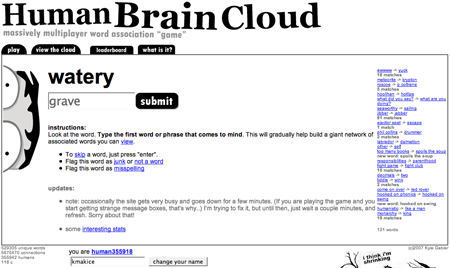As if I needed another distraction … enter the Human Brain Cloud.

Kyle Gabler’s Human Brain Cloud is a masterful time suck.
This massively multi-player game has been in the to-be-blogged bin for a while. Thanks to Josh Catone of the great blog Read/Write Web for profiling the web site on Tuesday, bringing it back to mind.
Although billed as multi-player, HBC is really an individual exercise—one that can quickly turn minutes into hours. You see a word or short phrase from the 530,000 already suggested by other players, and you enter the first response that enters your head. Although you type alone, you benefit from the wisdom of the masses. The word associations you make are scanned for matches and listed with the rest of your recent work. You can view the cloud, which is really a visual thesaurus kind of weighted network showing the connections to a given term.
There are also statistics showing leaders among both word associations and participants (most of whom show up as the default “human####” identifier one gets when failing to notice or ignoring the field to change your user handle). Stats are also kept on how you match up with the rest of the collective in terms of originality or conformity. The current record for a single session is 7321 associations by user I_have_no_life, who was 56% original.
HBC was a distraction project for creator Kyle Gabler while he helps finish another game (World of Goo) due to be released by 2Dboy in February. The network started from a single word—”volcano“—and has grown to a dictionary of more than a half-million terms and ten times that many connections. Every association made either strengthens an existing connection or adds a new node to the network. I am now one of 356,025 participants contributing to the experiment, although that number likely includes a percentage of return players, too.
Gabler includes a disclaimer about the value of the data—”This isn’t academically rigorous or anything, so set your expectations accordingly”—but there are potentially some interesting data mining and design inquiry that could benefit from the Human Brain Cloud as a resource. In his review, Catone pointed to some related academic work:
Researchers at the University of California recently conducted a study in which they found evidence to suggest that our brains catalog and rate the relevance of information by forming connections between data. The researchers compared the brain’s system to Google’s PageRank algorithm, but there are obvious similarities to the massive word association map that the Human Brain Cloud is compiling as well.
Last July, Gabler published some early statistics when the network was about one-fifth its current size. The Human Brain Cloud has the potential to produce enormously valuable information. Marketers could conceivably enter a term and check the related words, in part to avoid ambiguity and semantic competition, and partly to steer clear of easy targets for derogatory associations. Designers might peer into the brain of specific users to see how they make sense of certain words.
4 replies on “The Human Brain Cloud”
From my pal Mark:
[…] clipped from http://www.blogschmog.net […]
Have you checked out Google’s image labeler: http://images.google.com/imagelabeler/ ? Don’t know what they’re doing with the results, but they’d be cool to see.
That Google image game is great, although for me a bit buggy. I wasn’t clear that we were supposed to enter the labels individually, either, and started stringing them together. My poor anonymous partner had to endure a score of 670.
I like that approach to a rather tedious task: make it into a game. Unlike the Human Brain Cloud, there is a heightened interest with the short time commitment and the pairing with some other person willing to do the same tagging exercise.
Thanks for the link.